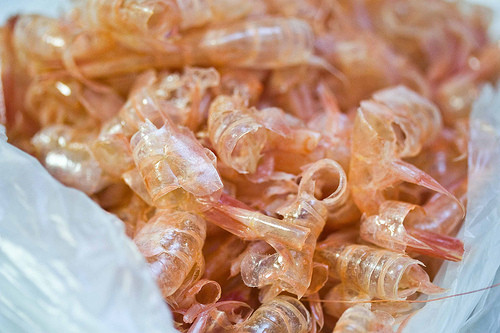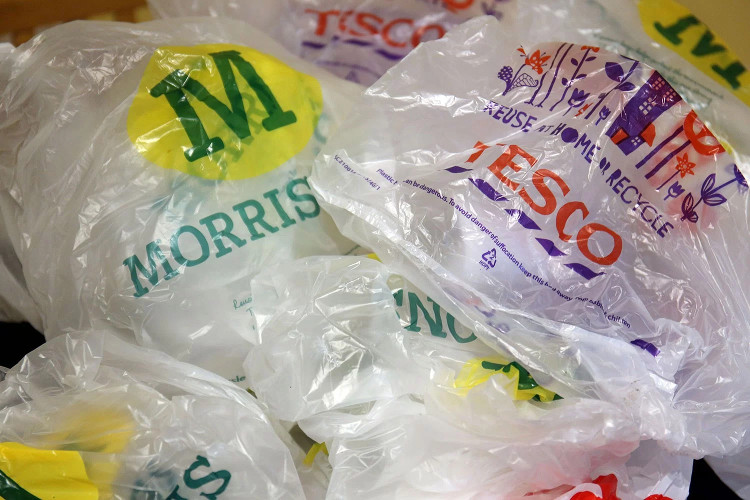Produce 'environmental bags' from shrimp shells
In addition to turning waste from shrimp shells into useful products, the project also contributes to reducing the amount of plastic bags used and accumulating in the environment, causing adverse impacts on the ecological environment as well as residents. direction.
The study is a collaboration between the University of Nottingham and the Egyptian government through the Nile River University.

Shrimp shells are a promising source of material being wasted today.
Using shrimp shells as materials to produce bags for trading activities will be the target of the research team.
Since plastic bags are used, its environmental damage is increasing because plastic bags are unable to decompose and reproduce themselves. Initially, the group will focus on applications in Egypt to assess the potential and economic efficiency of using shrimp shells to produce bags.
The technology used here is to form chitin chitosan polymer chains found in shrimp shells transferred from the University of Nottingham, UK. The idea is to create a product that is both effective and biodegradable and environmentally friendly.

Plastic bags produced by non-biodegradable materials extracted from petroleum are currently a problem of the earth's environment.
"Using bio-polymer extracted from biodegradable shrimp shells to produce bags instead of plastic bags will contribute to reducing carbon emissions and accumulating non-degradable garbage ", Nicola Everitt - assistant professor at the university Nottingham said
Besides replacing plastic bags for daily shopping, this new material can also be used in food packaging, products from chitosan are antibacterial and help prolong food preservation time.
"In addition to the purpose of turning waste from shrimp shells into useful products, the project also contributes to reducing the amount of plastic bags used and accumulating in the environment, causing adverse impacts on the ecological environment as well as residents. local " - Everitt added.

The project expects to minimize the harmful effects of plastic bag waste on people's lives and the regional environment.
Chitosan and some applications in food preservation
1. Membrane chitosan
Chitosan is a biological polymer , which is of interest to many scientists worldwide because of its good effects on cancer patients. The two major research countries of Chitosan are China and Japan.
In Vietnam, Chitosan produced from shrimp shells has been used instead of borax in the production of rice paper and rice cakes . Recent studies in Vietnam have been successful with Chitosan applications for shells. Preserving fresh and perishable foods such as fish, meat, vegetables . without losing color and flavor of the product.
2. Origin of chitosan
Chitosan is an acetyl-reduced chitin, but unlike chitin it is soluble in acid solution. Chitin is a biologically active polymer that is second only to cellulose. The chemical structure of chitin is similar to cellulose.
Both chitin and chitosan have many applications in industry and life, especially in food processing and preservation.
Chitin is derived from the word "chiton" , Greek for armor. Chitin is the main structural component in the shell (exoskeleton) of invertebrates including crustaceans (shrimp, crabs). When processing crustacean seafood, the amount of waste (containing chitin) accounts for 50% of the input volume and this figure is calculated worldwide at 5, ll million tons / year.
Therefore, the processing of chitosan films has partly solved the amount of waste, indicating that the potential of this membrane is very high.

Images of fiber structure were supplemented with chitosan based on percentage: (A) 2%, (B) 3%, (C) 4%, (D) 5%, (E) 6%, and (F ) 7%.
3. Characteristics of chitosan
- Polysacharide is a non-toxic protein with a large molecular weight.
- It is a solid, spongy, light, scaly-shaped substance that can be grinded in different sizes.
- Chitosan is white or light yellow, without taste.
- Insoluble in water, concentrated alkaline and acid solutions but soluble in dilute acid (pH6), creating clear colloid solution, capable of good film formation, melting temperature 309 - 311 o C.
4. Effect of chitosan
- Biodegradability is easier than chitin.
- Chitosan and its derivatives have antibacterial properties, such as inhibiting the activity of some bacteria such as E.Coli, killing some types of strawberries, carrots, beans and have good effects in health. manage vegetables with a hard outer shell.
- When using chitosan membrane, it is easy to adjust the humidity and air permeability of food (If using PE packaging, the oxygen supply is limited, the water will be condensed to create an environment for mold growth).
- Chitosan film is also quite tough, difficult to tear, has the same durability as some plastics that are still used as packaging.
- Membrane chitosan slows the darkening process of vegetables. After harvest, vegetables will gradually darken, reducing quality and value.
Dark fruits and vegetables are due to fermentation that produces polymerization products of oquinones. By encapsulating with chitosan membrane, it inhibits the oxidative activity of polyphenols, constitutes the composition of anthocyamin, flavonoids and the total amount of less modified phenol compounds, keeping fruits and vegetables longer.
- The truth about shrimps is that many people think they know that they turned out to be wrong
- India banned the sale of plastic bags for the environment
- Shrimp shells are not garbage
- Students create solutions from shrimp shells to keep fresh produce for more than 10 days
- Shampoo from shrimp shells decomposed
- Shrimp shells help reduce cholesterol
- Risk of death when combining shrimp with vitamin C
- Super-durable plastic materials, self-destructible are made from shrimp shells and silk
- Vietnam prohibits the production of plastic bags that are difficult to decompose
- The octopus with the shrimp has a quick punch like a bullet, who will win?
- Russia makes new burns with nanofibers
- Strong with 'white pollution'
 Is the magnetic North Pole shift dangerous to humanity?
Is the magnetic North Pole shift dangerous to humanity? Washington legalizes the recycling of human bodies into fertilizer
Washington legalizes the recycling of human bodies into fertilizer Lightning stone - the mysterious guest
Lightning stone - the mysterious guest Stunned by the mysterious sunset, strange appearance
Stunned by the mysterious sunset, strange appearance